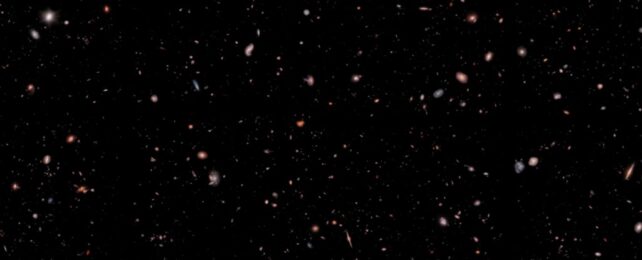A deep dive into a deep field captured by the James Webb Space Telescope gives us a sense of impossible spaceflight – and the way galaxies changed over the history of the Universe.
For a survey called Cosmic Evolution Early Release Science (CEERS), the JWST peered deep into a small patch of space known as the Extended Groth Strip, imaged by Hubble in 2004 and 2005. There, tens of thousands of galaxies extend back into the Cosmic Dawn, laying out the evolution of the Universe.
JWST's CEERS observation focused on a small section of the strip containing 5,000 galaxies. But it's not just any section: At the very farthest reaches of JWST's view is a small, red blob known as Maisie's Galaxy. At just 390 million years after the Big Bang, Maisie's Galaxy is one of the earliest galaxies we've ever seen.
In a new scientific visualization of the CEERS field, we can now zoom through space and time, back to the dawn of the Universe, to Maisie's Galaxy. It's a journey we could never actually take – we'd have to break many laws of physics to travel faster than light speed through space and also backward in time – but it highlights how ridiculously good we've become at peering into the far fringes of our Universe.
"This observation exceeded our expectations," says CEERS principal investigator Steven Finkelstein of the University of Texas, Austin. "The sheer number of galaxies that we're finding in the early Universe is at the upper end of all predictions."
It's been a year since JWST gave us its first epic images of the infrared Universe, and programs like CEERS have given us so many surprises. We can't wait to see what comes next.
